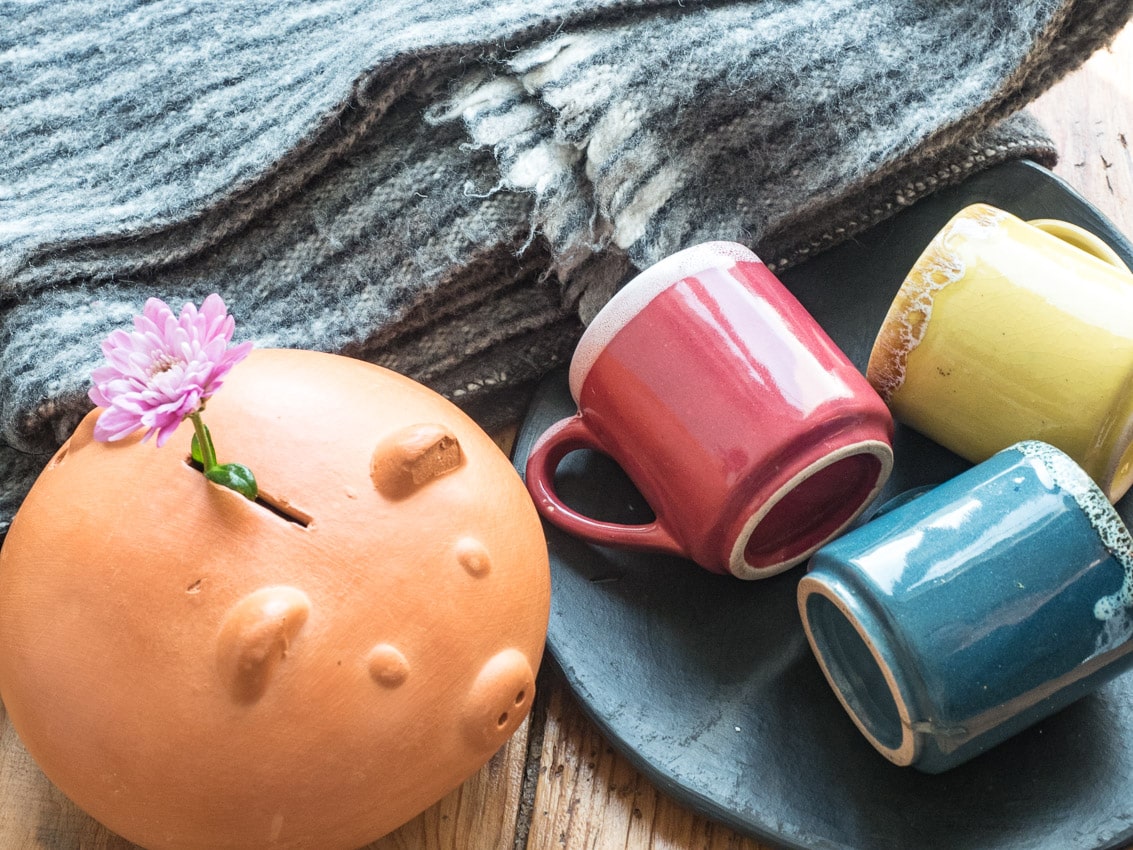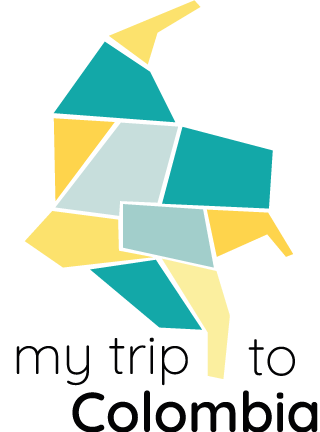Raquira is one of my favorite villages in Colombia. Like Villa de Leyva, Raquira is a village I’ve been visiting fairly regularly since I was a little girl.
Being close to Bogotá, it was easy to escape there over the weekend with my family to admire the crafts or simply stroll around enjoying the colors and calm rhythm of the village.
We set off for Raquira from the Villa de Leyva bus station. The weather is fine, and we take a seat next to the driver.
The driver tells me all about his life, his hopes of seeing his child go to university on a scholarship (higher education is not easy for everyone in Colombia, it’s very expensive), and this touches me deeply.
We chat, laugh and the 40-minute drive goes by quickly. He leaves us at “3 Esquinas”, a service station on the road where cabs are waiting to take us to the entrance of Raquira.
Disclaimer: we apologize in advance for any grammatical or syntactic errors, as our native language is not English (we're a Colombian-French couple), so we hope you'll forgive us and still enjoy the information we share with you! Please note that all the information on our blog is based on our own experience, and is checked and updated regularly.
Contents
Related posts

Exclusive 5% Off Discount For you
Best Travel insurance for Colombia
Our partner offers the best rates and a 5% discount for our blog readers! (regardless of travel dates)
Raquira, capital of pottery
Visit Raquira in the Boyaca region

Raquira is the pottery capital of Colombia, and its inhabitants have been working with clay since pre-Columbian times, a tradition that is still very strong today.
You’ll find plenty of workshops and colorful facades adorned with handicrafts that add to the charm of the main street.






As you walk up this street, you come to the central square, which I love, with its huge terracotta statues that stand there, paying homage to the region’s artisans and emblematic figures. In the middle, a small fountain with its own “criollo” manneken-piss completes the picture.
I love this square, there’s something so simple yet so authentic about it… I adore this village’s peaceful energy and the beauty of the little grannies weaving, knitting and keeping traditions alive.
These peasant women, with their hats and ruanas that give them such a special grace..






Then it’s back to the shopping street, where we browse for gifts in the handicraft stores.
Our finds? Small coffee mugs, black earthenware plates, ruanas for winter (a Colombian wool poncho typical of the Boyaca region) and a small terracotta pig/tire-book, our “marranito”, which we’ll call “Rupertino”.
It’s a local tradition, a pig without a hole that you have to break with a hammer to get the money. Today, it sits on our bedroom mantelpiece, and will serve as a kitty for our next trip!



One of the most moving moments of the day was our encounter with a little granny who spins virgin wool.
Her face is beautiful. And so is her outfit. She doesn’t want to be photographed, but tells us her story of walking down from the mountains every day to sell her wool in the village since she was a little girl..
It’s impossible to imagine the harshness of this lady’s life, yet her face and voice exude gentleness.
Raquira and its colors
From Nairo Quintana to the Muiscas

The houses here are bursting with color, but in a very different style to that found in Salento, the colorful village in the coffee zone. The facades are decorated with “frescoes” alluding to the ancient Muiscas peoples who used to live here.
There are also drawings paying tribute to Colombian sportsmen and women, such as the soccer team or cyclist Nairo Quintana, a native of the region: as everywhere in Colombia, when you’re proud, you show it!
For all these reasons, I wanted to visit Raquira with Samuel. I knew he’d enjoy it, and by being together, this visit would be very different from the others.





This morning, we have an appointment with Alex, a friend of my cousin’s who, like many villagers, belongs to a family of artisan potters. We have a long chat with him in the village square. He tells us a little about the local history, life here and his pride in being a native of this beautiful village. We also talk about the situation in Colombia and the referendum on the peace process that had just been held, and which was, at the time, the central topic in the country.
After this exchange, we agree with Alex to take a tour of his pottery factory and a short introduction to the workshop. But that won’t be for a while, as the whole village is in complete blackout: no one has any electricity! One of the charms of a trip to Colombia..





We take the opportunity to have a look around. Strayed from the central axis, we wander down a few alleyways and discover some beautiful houses.
After a few hours of waiting, the electricity is finally back on!
Visit a pottery workshop
Best things to do in Raquira, Boyaca

We set off for Alex’s small pottery factory high up in the village. He explains to us all the stages of production, from the raw clay taken from the ground to the final glazed pot ready for sale.
Alex is passionate about his work and shares his enthusiasm with us. He’s keen to share this local know-how, and in the near future he’d really like to develop a tourist section so that passing travelers can enjoy an immersion in this raquireña tradition.




We then head upstairs to his father’s workshop. This is where we’ll have a little introduction to pottery !
It was great and full of laughter! We’d never tried it before, and it’s not as easy as it sounds. But it’s an incredible feeling to see the material forming under your fingers, and what a material it is! Clay is magic.
How do I meet Alex?
Visit the pottery workshop
- Duration / Price: Tour of the factory and mini-introduction to pottery: approx. 1 hour – $30.000 COP per person.
- Please note: Visit in Spanish only for the moment.
- Tel (Whatsapp): 57 321 308 2699
Alex will be delighted to welcome you and show you around his village and factory. For a complete immersion experience, Alex also rents out self-catering cottages and offers tours of the region’s main attractions for those wishing to stay a few days in his company. And say hello to him from Angélica and Samuel!
Even if it was difficult to find the right gesture, there’s something very soothing about the feeling of having that earth slip through your fingers.




Meeting Alex, visiting his factory and learning how to make pottery is one of the best memories of our trip. We can only recommend that you get in touch with Alex to visit his pottery workshop if you happen to be in the area.
Where to stay in Villa de Leyva
Raquira is sure to be a day trip when you’re in Villa de Leyva, so here’s our advice on where to stay in Villa de Leyva.
Villa de Leyva

Hostal
Nibiru Hostal
Double room : $0 to $100.000 COP
A well-decorated hostel with great facilities at a great price. The house is modern, clean, the breakfast is top-notch and the owners are very friendly!
Villa de Leyva

Hostal
Hostal Casa Beija Flor
Double room : $0 to $100.000 COP
Communal areas that make you want to chill out, clean rooms and bathrooms, a friendly welcome… that’s what you’d expect from a good hostal!
Villa de Leyva

Hotel
Hotel Casa Cantabria
Double room : $150.000 to $200.000 COP
A hotel recommended by our readers, located two blocks from Villa de Leiva’s main square, this beautiful colonial house offers excellent value for money. Special mention for the small roof terrace!
Villa de Leyva

Hotel
Hospederia Villa de los Saenz
Double room : $150.000 to $200.000 COP
This address was recommended to us by Angélica’s uncle, who recently tried it out. The hotel is very close to the main square, which is good, it’s clean, traditionally decorated and reasonably priced.
Villa de Leyva

Hotel
Hotel Arco Iris
Double room : $150.000 to $200.000 COP
This is where we stayed during our stay at Villa de Leiva. A beautiful, romantic hotel high above the village, with large bay windows overlooking the surrounding mountains, terrace and fireplace if required… we loved it. The hotel is off the beaten track, so you’ll need to take a cab to get to the village.
How to get to Raquira
Direct from Bogotá
You can travel directly to Raquira from Bogotá and then on to Villa de Leyva. To do this, choose the bus companies that run the route via Zipaquira – Ubate – Guacheta.
Don’t hesitate to ask the ticket offices at the Salitre or Terminal del Norte terminals in Bogotá where to catch the bus.
- Duration: approx. 3 hours
- Price: $22.000 COP
From Villa de Leyva
From the Transport Terminal, ask for the “buseta” to Raquira (we advise you to call the day before to confirm departure times). Please note that the buseta does not take you directly to Raquira. The driver will leave you at a place called “3 Esquinas”, where cabs are waiting to take you the rest of the way to Raquira.
- Duration: approx. 40 minutes
- Price: $6.000 COP
- Departure times: 6 a.m. – 8:30 a.m. – 2 p.m. – 4 p.m. – 5 p.m
- Return timetable: the last bus leaves around 5:30 p.m
Where to eat in Raquira
There aren’t many options for eating out in Raquira. However, following Alex’s advice, here are some suggestions:
Restaurant Cazuelas Boyacenses
Located on one of the corners of the main square, it’s quite large and hard to miss. Typical Boyacan cuisine
Restaurant los tiestos
Not too far from the main square, also typical Boyacan cuisine, it has the best reviews on TripAdvisor, if that ever helps.
Alternative plan
Consider stopping off at Sutamarchan for a bite to eat before arriving in Raquira. You’ll be able to taste longaniza, a kind of “chorizo” that’s very fine and very good! This is the village’s typical cold meats, reputed to be the best in Boyaca.
Souvenirs from Raquira
If, like us, you love handicrafts, you’re sure to find something to your liking in Raquira! Among the village’s typical and traditional products:
- Terracotta objects and crockery
- Virgin wool products such as ruanas (the traditional poncho of the Colombian Andes)
- Piggy banks
- Mobiles and other small decorative objects
- Hammocks
- Jewelry made from natural products such as tagua or flowers.
As mentioned above, we brought a lot of little things back with us. This allows us to bring back fond memories in the mornings, for example, as we sip coffee from our little raquireña cups.



